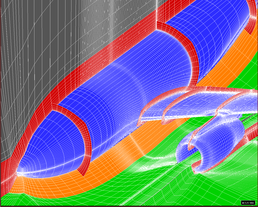FLOWer

Block-Structured Navier-Stokes Solver FLOWer
- solution of RANS equations for arbitrary moving bodies
- well adapted for external flows around aircaft-like configurations in subsonic, transonic and supersonic flow region
- efficient solver on vector & parallel computers
- computer platform independent
- high flexibility through discontinous block interfaces and overlapping grid technique (Chimera)
- inverse design option, adjoint solver for aerodynamic optimization
- development performed by a joined team from DLR, universities, Airbus Germany and EADS-M
- comprehensively validated
- routinely used by German Aircraft Industry, DLR and several Universities
For queries about this topic, contact Heinrich Luedeke.
Projects

Laminar to Turbulent Transition in Hypersonic Flows
Neil Sandham, Heinrich Luedeke
Understanding of laminar to turbulent transition in hypersonic boundary-layer flows is crucial for re-entry vehicle design and optimization. The boundary-layer state directly affects the temperatures on the vehicle surface and its viscous drag. Therefore transition has to be considered to correctly compensate for drag and to properly design the thermal protection system.
For the proposed study, in order to obtain a clear understanding of the transition process, the configuration is kept as simple as possible by varying only a minimum number of parameters affecting transition on a simple test geometry such as a swept ramp at different sweep angles. To investigate the influence of such sweep angles on the transition process in the hypersonic regime, Direct Numerical Simulations (DNS) of the turbulent flow field are carried out on the Iridis cluster.
People
 Neil Sandham
Neil SandhamProfessor, Engineering Sciences (FEE)
 Heinrich Luedeke
Heinrich LuedekeResearch Fellow, Engineering Sciences (FEE)
 Petrina Butler
Petrina ButlerAdministrative Staff, Research and Innovation Services